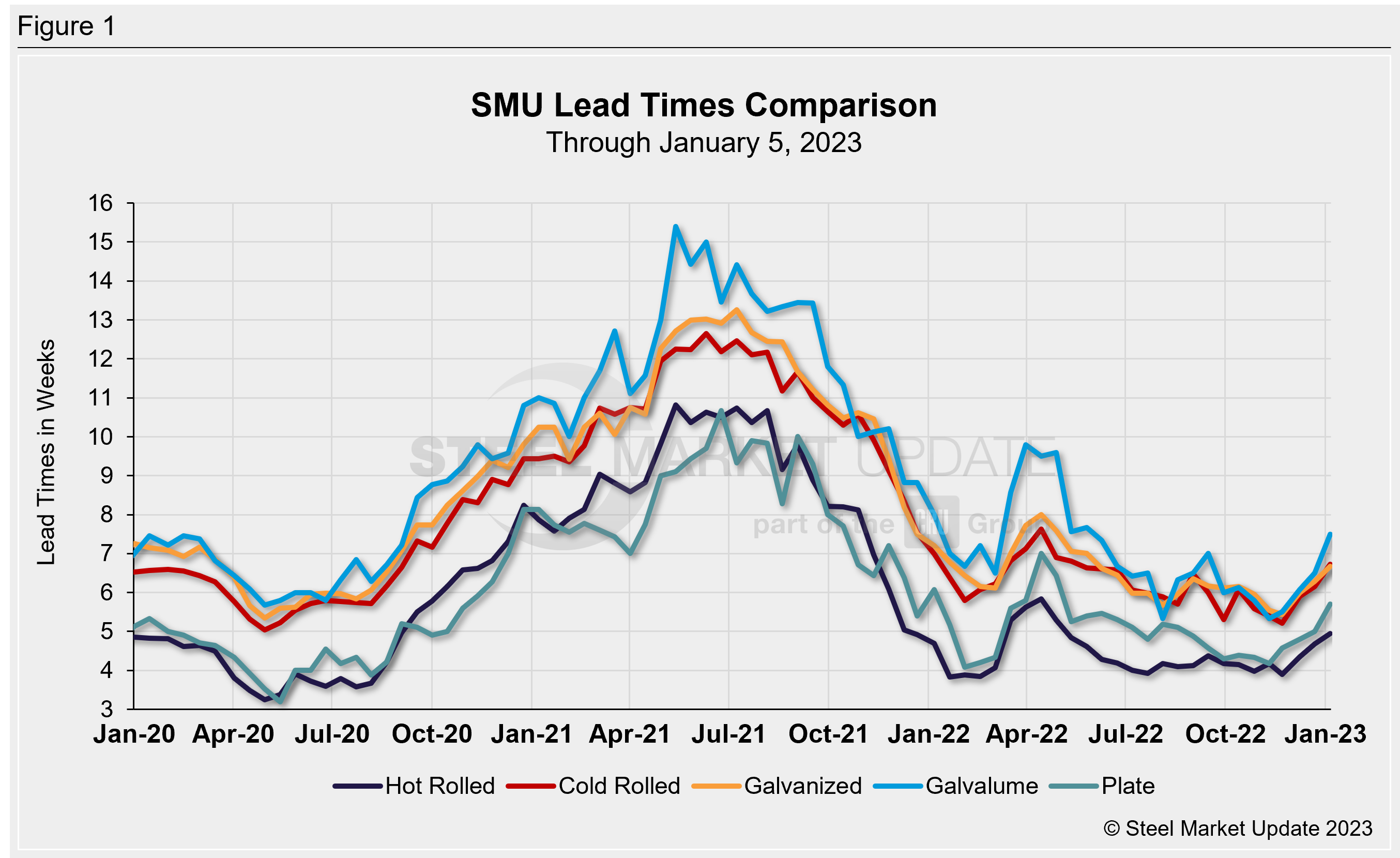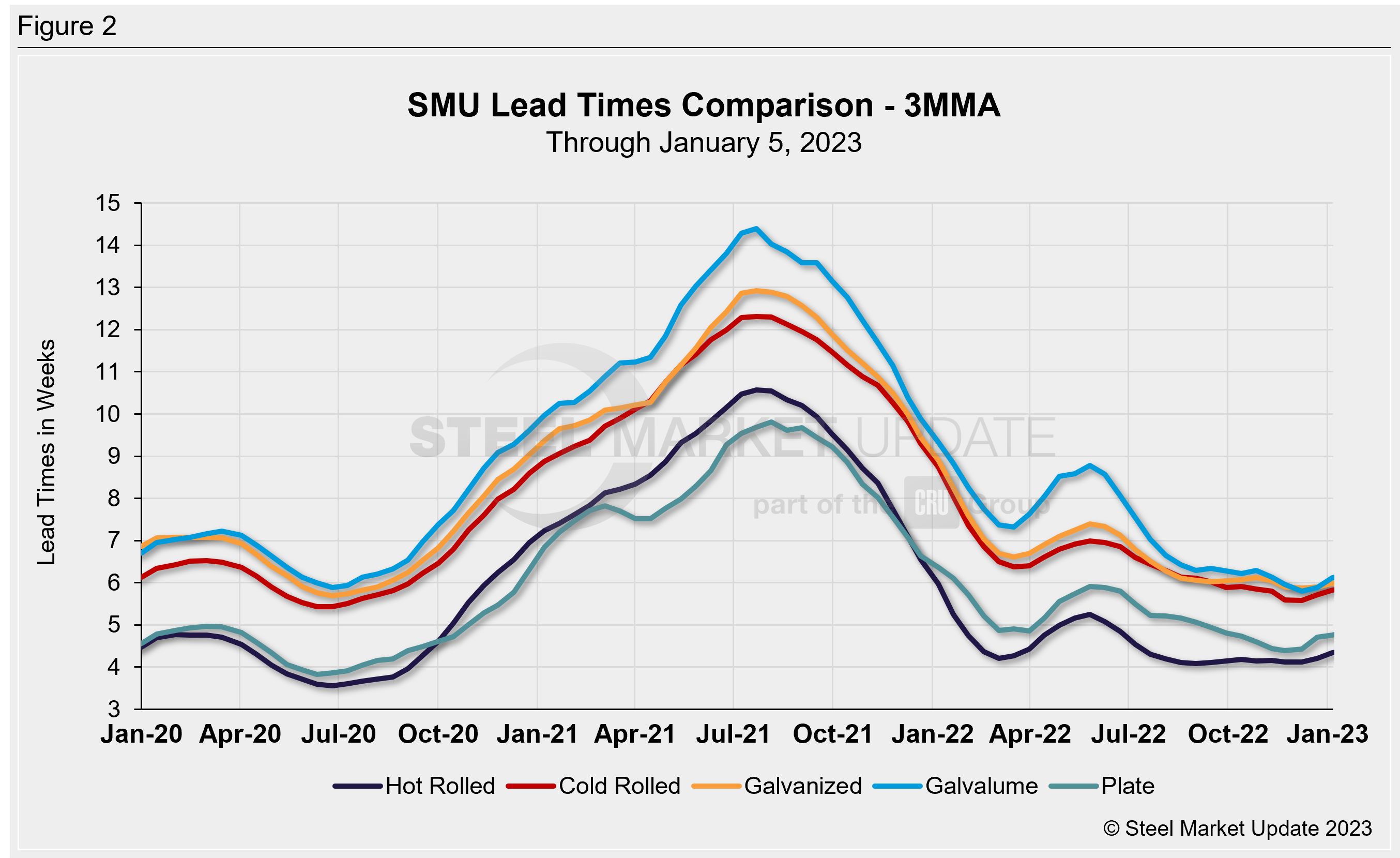International Steel Prices
Sheet Lead Times Increase Across the Board
Written by Becca Moczygemba
January 5, 2023
Steel mill lead times increased again this week, extending by an average of 0.6 weeks across all five products we track. You may recall that lead times for hot-rolled, cold-rolled, and galvanized products were at or near multi-year lows in our late November market check.
Lead times have increased an average of 0.9 weeks compared to levels two weeks ago. Following their April peak, sheet lead times were relatively stable at low levels from July to November. Plate lead times had gradually moved lower over the past six months but ticked up in mid-November.
Steel buyers reported mill lead times ranging from 4 to 7 weeks for hot rolled and plate, and 5 to 9 weeks for cold rolled, galvanized, and Galvalume.
SMU’s hot-rolled lead time extended by 0.3 weeks to 5 weeks, the highest level since May. Six weeks ago, our hot-rolled lead time reached a low of 3.9 weeks. The shortest hot-rolled lead time recorded this year was 3.8 weeks in January/February. Recall the record low in our ~11-year data history was 2.8 weeks in October 2016.
Cold-rolled lead times also stretched by 0.5 weeks to 6.7 weeks, and are now at the highest level since early September. Cold-rolled lead times fell to 5.2 weeks in late November, the lowest reading since May 2020.
Following the same trend, galvanized lead times increased 0.4 weeks to 6.7 weeks and are now at an 18-week high. Galvanized lead times are up one full week compared to one month ago. Like other products, our galvanized lead time in late November was the shortest seen since April 2020. The record low was 4.8 weeks in February 2015.
Galvalume lead times rose one full week to 7.5 weeks. This is also up one full week compared to levels one month ago. Note that Galvalume figures can be volatile due to the limited size of that market and our smaller sample size.
Plate lead times rose 0.7 weeks to 5.7 weeks, their highest reading since mid-August. In early November, plate lead times were 4.2 weeks—the lowest lead time recorded since February (4.1 weeks). In our four-year history for plate, the shortest plate lead time we have on record is 3.2 weeks in May 2020.

When asked about the future direction of lead times, 65% of executives responding to this week’s questionnaire expect lead times to be relatively flat into February. This is down from 66% in our previous survey. On the other hand, 26% of buyers think lead times will extend, down from 28% two weeks ago. Nearly 9% expect lead times to contract, in line with results from as far back as late October. Premium members can view a longer history of this data series and others by exploring the market trends report.
Looking at lead times on a three-month moving average (3MMA) basis can smooth out the variability in the biweekly readings. As a 3MMA, lead times for all products were flat to down compared with late November. The latest 3MMA lead time for hot rolled inched up to 4.3 weeks. It has remained in this territory since August. Cold-rolled lead times also moved up to 5.8 weeks. Galvanized lead times moved to 6 weeks, while Galvalume lead times increased by 0.2 weeks to 6.1 weeks. Plate lead times moved 0.4 weeks to 4.8, rebounding from the lowest 3MMA measure recorded since September 2020.

Note: These lead times are based on the average from manufacturers and steel service centers who participated in this week’s SMU market trends analysis. SMU measures lead times as the time it takes from when an order is placed with the mill to when the order is processed and ready for shipping, not including delivery time to the buyer. Our lead times do not predict what any individual may get from any specific mill supplier. Look to your mill rep for actual lead times. To see an interactive history of our Steel Mill Lead Times data, visit our website here.
By Becca Moczygemba, Becca@SteelMarketUpdate.com

Becca Moczygemba
Read more from Becca MoczygembaLatest in International Steel Prices

US and offshore HRC prices tick lower
The threat of tariffs over the past two months has been a springboard for US prices. But the Section 232 reinstatement on March 13 narrowed the domestic premium over imports on a landed basis.

Domestic CRC prices surge ahead of imports
The price spread between stateside-produced CR and imports reached its widest margin in over a year.

US HR prices rising faster than offshore tags
Hot-rolled (HR) coil prices continued to rally in the US this week, quickly outpacing price gains seen abroad. The result: US hot band prices have grown widely more expensive than imports on a landed basis. The premium US HR tags carry over HR prices abroad now stands at a 14-month high. SMU’s average domestic HR […]

US HR price premium over imports widens
Hot-rolled (HR) coil prices were flat in the US this week, while tags in offshore markets were mostly down.

US HR price premium over imports edges up
The price premium between stateside hot band and landed imports widened slightly this week.
